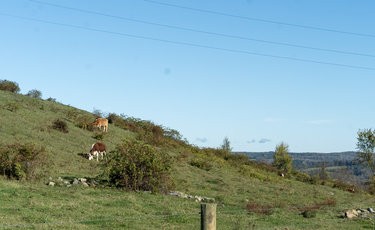Farmer concerned over delay in proposed Berne solar project
BERNE — Jody Jansen is advocating for the solar facility he wants to put on his farm.
In January, RIC Energy, operating under Berne PV LLC, submitted an application for site-plan review of a 3.8-megawatt facility on his farm at 28 Jansen Lane in Berne.
According to Weston Hillegas, a project development manager at RIC, the project was moving through the approval process with the town’s zoning board as the lead agency for the State Environmental Quality Review and had been recommended to the planning board.
“And then out of the blue, a moratorium came down from the town board,” he said. “They brought up issues of battery energy storage and we made it clear to them that this project didn’t have any of that proposed and it would never have it proposed.”
He went on, “Something to do with the batteries, I think, is what was really setting them off. Or maybe they were just using that as an excuse.”
The town currently has no commercial solar facilities but two were in the pipeline for approval when the board in April proposed a year-long moratorium. The moratorium was adopted in May and expires in May of next year.
The other proposal that was halted by the moratorium is a 4.25-megawatt facility proposed by TJA Energy in January 2024 that would be located at the intersection of Switzkill and Canaday Hill roads.
Solar moratoriums have been common in the Hilltowns, which, because of their plentiful open spaces, are attractive to solar developers. Berne, however, is unique in that it not only already had a robust solar law, but had significantly revised the law just a few years ago.
The relatively strict original law had been passed by a Democrat-majority board in 2019, and Republicans took the opportunity to make it more favorable to solar developers after gaining control of the board in 2020.
Neither version of the law, however, included regulations for battery storage, which most town legislate separately from regulations for solar facilities.
Jansen’s view
Jansen writes in a letter to the editor published in this week’s edition of The Enterprise, “As a fifth-generation family farmer in Berne, I believe it is time for our town to embrace smart opportunities that will contribute to our town’s revenue and support our taxpayers.”
Jansen claims some Berne leaders are against the project and also says he is still getting criticized from some residents in town for allowing the county sheriff’s 911 tower to go on his farm.
“They’re saying, ‘Well, if you can’t afford the property, why don’t you sell your farm?’”
Jansen’s family has farmed the land off of Irish Hill Road — his driveway is named Jansen Lane — for five generations and he would like to pass the farm along to his children.
He currently raises beef cattle on what he says is a 123-acre property. “The old deed said 166,” he said of acreage. He and his wife, Barbara, live in the 1872 farmhouse on the property, which they’ve improved over the years.
“We put up a big barn seven or eight years ago and I wanted to get a mortgage on the land,” he said. “The bank said, ‘You don’t need a mortgage’ … I never had a mortgage on it and neither did my father. My father did a lot of blood and sweat. There’s been a lot of blood, sweat, and tears on our property — "
“To keep it in the family,” chimed in his wife.
Only two households would be able to see the solar facility from their homes, Jansen said.
“There’s two fields there. And actually, you’re only going to be able to see the one field because the other one’s up higher.”
He went on, describing advantages of the site, “There’s no trees, nothing to cut. The only thing you’d have to cut is a hedgerow. Hedgerows grow up on farms — you try to take them out anyway.”
Jansen envisions his cattle grazing alongside the solar facility.
The proposal
According to project documents on the Berne town website, the facility would occupy 23 acres on the 160-acre property, and would need two area variances — one to be situated less than 200 feet from the property’s southern border, and the second to be less than 100 feet from wetlands — in addition to a special-use permit.
Studies concluded that noise, glare, and environmental impacts would be negligible.
“We’ve really completed everything that the town has asked for,” Sinead Ross, who handles marketing for RIC, told The Enterprise this week.
She went on, “They were looking for a visual impact assessment that was done as of last May where we had blue balloons put out. And then we asked for anyone to write back if they could see the balloons and there wasn’t anything that was considered a concern.”
On the requirement from the southern border, Hillegas said, “We were roughly 100 feet away from it, so not the [required] 200 feet obviously but we felt we were far enough away … That whole edge of the property is just completely forest.”
He said the nearest house was over 2,000 feet away.
Hillegas also said that RIC had consulted with the state’s Department of Environmental Conservation about the required 100-foot setback from the wetlands.
“We proved to them and got jurisdictional determination from the DEC that they’re not DEC jurisdictional wetlands anyway,” he said. “But we still have to abide by the town law.”
Hillegas also said, “The wetlands that we are within 100 feet of are actively farmed right now. So it actually will be beneficial to those wetlands to not be farmed anymore.”
RIC plans to proceed “as soon as the moratorium is lifted if the solar law hasn’t changed too much,” Hillegas said. “We’ll have to re-evaluate that and, if they change the solar law, I think that will give us more insight into intentions.”
He concluded, “We’re willing and hoping and wanting to work with all parties involved. I even got the discussion started with the local fire department. They had a couple concerns,” he said, naming access.
“We’re willing to work with them and put in an access road in a different location if it’s beneficial to them,” said Hillegas. “So we’re by no means set in stone on what we initiated with our plan. We’re able to mold and mend and work with everybody.”

